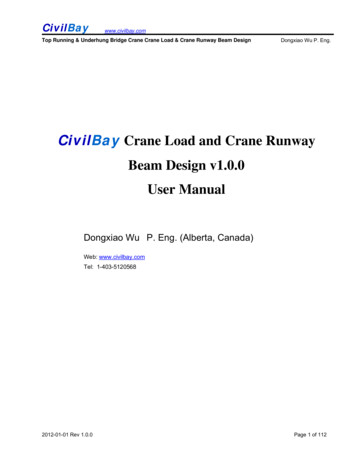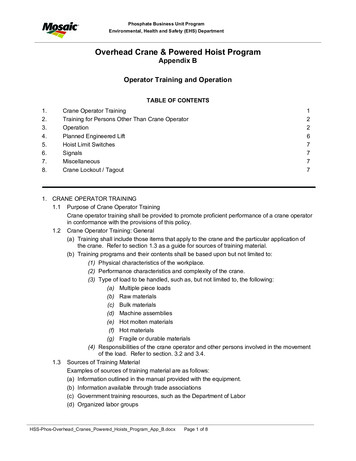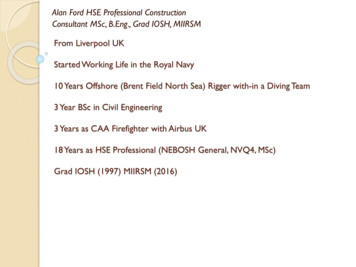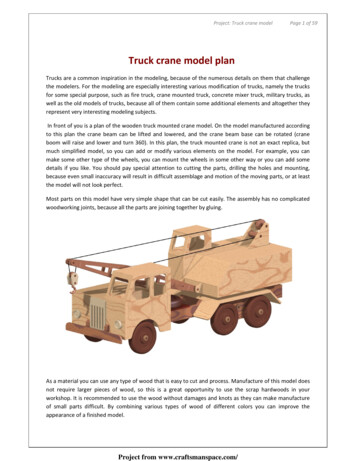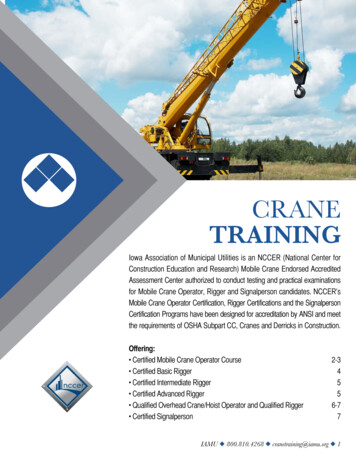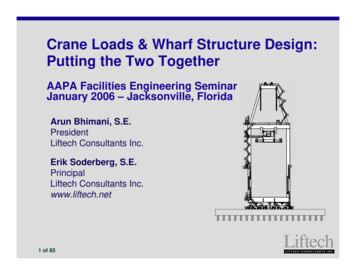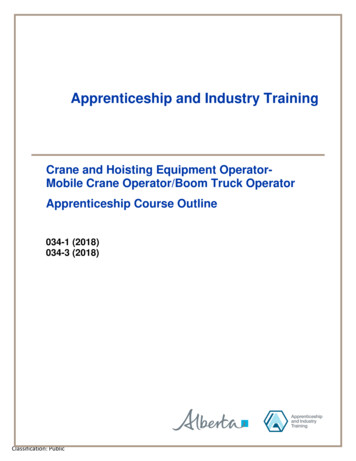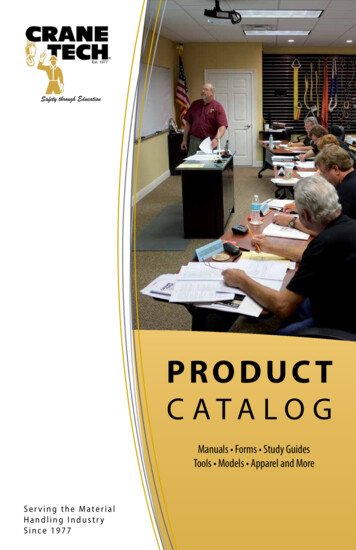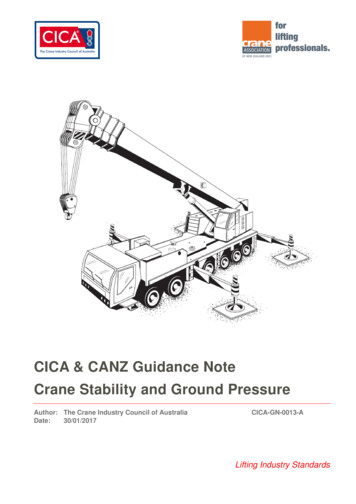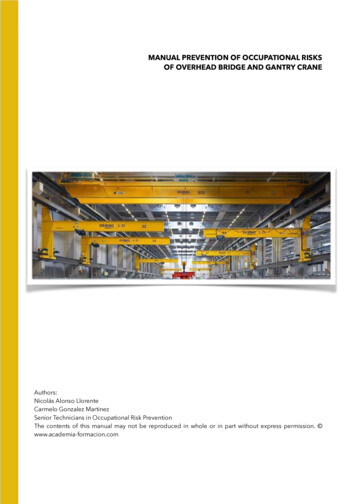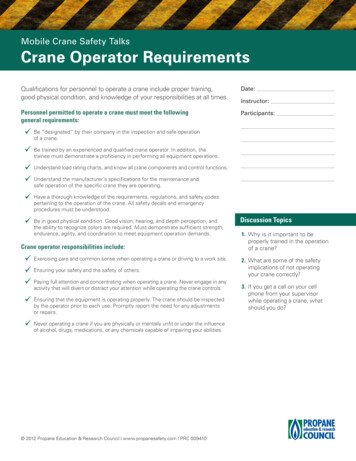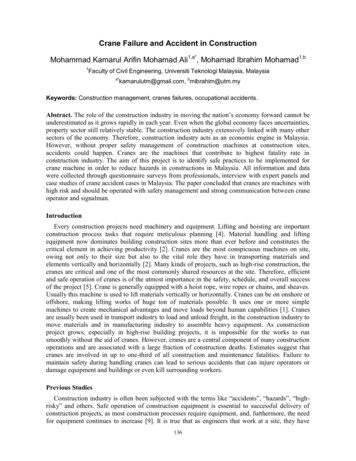
Transcription
Crane Failure and Accident in ConstructionMohammad Kamarul Arifin Mohamad Ali1,a*, Mohamad Ibrahim Mohamad1,b1Faculty of Civil Engineering, Universiti Teknologi Malaysia, Malaysiaa*kamarulutm@gmail.com, bmibrahim@utm.myKeywords: Construction management, cranes failures, occupational accidents.Abstract. The role of the construction industry in moving the nation’s economy forward cannot beunderestimated as it grows rapidly in each year. Even when the global economy faces uncertainties,property sector still relatively stable. The construction industry extensively linked with many othersectors of the economy. Therefore, construction industry acts as an economic engine in Malaysia.However, without proper safety management of construction machines at construction sites,accidents could happen. Cranes are the machines that contribute to highest fatality rate inconstruction industry. The aim of this project is to identify safe practices to be implemented forcrane machine in order to reduce hazards in constructions in Malaysia. All information and datawere collected through questionnaire surveys from professionals, interview with expert panels andcase studies of crane accident cases in Malaysia. The paper concluded that cranes are machines withhigh risk and should be operated with safety management and strong communication between craneoperator and signalman.IntroductionEvery construction projects need machinery and equipment. Lifting and hoisting are importantconstruction process tasks that require meticulous planning [4]. Material handling and liftingequipment now dominates building construction sites more than ever before and constitutes thecritical element in achieving productivity [2]. Cranes are the most conspicuous machines on site,owing not only to their size but also to the vital role they have in transporting materials andelements vertically and horizontally [2]. Many kinds of projects, such as high-rise construction, thecranes are critical and one of the most commonly shared resources at the site. Therefore, efficientand safe operation of cranes is of the utmost importance in the safety, schedule, and overall successof the project [5]. Crane is generally equipped with a hoist rope, wire ropes or chains, and sheaves.Usually this machine is used to lift materials vertically or horizontally. Cranes can be on onshore oroffshore, making lifting works of huge ton of materials possible. It uses one or more simplemachines to create mechanical advantages and move loads beyond human capabilities [1]. Cranesare usually been used in transport industry to load and unload freight, in the construction industry tomove materials and in manufacturing industry to assemble heavy equipment. As constructionproject grows, especially in high-rise building projects, it is impossible for the works to runsmoothly without the aid of cranes. However, cranes are a central component of many constructionoperations and are associated with a large fraction of construction deaths. Estimates suggest thatcranes are involved in up to one-third of all construction and maintenance fatalities. Failure tomaintain safety during handling cranes can lead to serious accidents that can injure operators ordamage equipment and buildings or even kill surrounding workers.Previous StudiesConstruction industry is often been subjected with the terms like “accidents”, “hazards”, “highrisky” and others. Safe operation of construction equipment is essential to successful delivery ofconstruction projects, as most construction processes require equipment, and, furthermore, the needfor equipment continues to increase [9]. It is true that as engineers that work at a site, they have136
high potential on hazards and accidents. Generally, construction risk can be classified to 3 mainfactors, which can be categorized into three classes: due to client, due to contractor (the builder) anddue to designer. Cranes are involved in up to one-third of all construction and maintenance fatalities[3]; [8] crane. Cranes, which come in numerous congurations and are a critical component of mostconstruction work, contribute to as many as one-third of all construction and maintenance fatalitiesand injuries resulting in permanent disability [3] ; [6].Using machines have their own hazards especially tower crane machines. One of the majorcauses of fatalities during construction is in the use of cranes or derricks during lifting operations[10]. Tower crane is the largest machine that been use in construction sites, yet it provide thebiggest risk to site workers. Although been equipped with advance safety technologies, accidentslike blind lifting and poor communication can lead to machine failure and fatality [7]. Cases liketower crane fell from 11-storey high at construction site near Damansara on 15 April 2014 thatkilled Mohd Hafadz Sanip, the operator for the crane have open engineers’ eyes on taking safetyseriously.For every type of crane, they have different type of failure. For example, mobile crane failsbecause of poor stability during lifting and tower crane fails because of fail of crane steel supportstructure. These crane failures are dangerous, as it can lead to permanent disabilities or even death.Occupational Health and Safety (OSHA) had come with many standards of safety at site tominimize hazards and accidents during construction works in order to cope with the potential riskson the site. The site workers have to follow these regulations to increase safety level in theirconstruction.MethodologyThe methodology used in this research is shown in Figure 1. The objectives were achievedthrough the questionnaire survey, case study and interview with expert panels in order to compilethe information related to crane safety in construction industry.In this study, the primary data have been collected from the questionnaire surveys which havebeen sent to all professionals at selected organizations, case studies of selected cases on craneaccident and failure in Malaysia and interview with expert panels. Meanwhile, the secondary datahave been gathered from several sources such as journals, articles, books, internet and previousresearches.The questionnaire consists of 3 sections which correspond to the objectives of the study. Thefirst section is background respondents; the second section is to obtain information on the maincause of crane accident in terms of mobile crane and tower crane; the third section to identify therecommendations to minimize crane failure in construction.After collecting the data obtained from questionnaire, data analysis will be carried out by usingMicrosoft Office Excel 2010. The data then will be analyzed by using frequency distributionanalysis and chart diagram such as bar chart will be used to visualize the result from the analysis.݊ ݏݐ݊݁݀݊ ݏ݁ݎ ݂ ݎܾ݁݉ݑ x 100%Σ ݏݐ݊݁݀݊ ݏ݁ݎ ݂ ݎܾ݁݉ݑ݊ ݈ܽݐ ݐ Formula for percentage frequency analysis The classification of the rating scales proposed by Majid and Mc Caffer (1997) is used. Theclassification of the rating scales are as follows:Likert scaleRange1 Strongly Disagree(1.00 Average Index 1.50)2 Disagree(1.50 Average Index 2.50)3 Slightly Agree(2.50 Average Index 3.50)4 Agree(3.50 Average Index 4.50)5 Strongly Agree(4.50 Average Index 5.00)137
Figure 1: Flow Chart of MethodologyData AnalysisIn this research, the method been used to collect the data are questionnaire survey, interview withexpert panels and case studies.Questionnaire Survey A total of 30 sets of questionnaire was then distributed to the contractors andengineers at the selected site, 30 responses were received within the desired period which is equal to100% of the total rate of responses. The data obtained can provide effective information to achievethe objectives of this study.Respondents Information. These surveys have identified several numbers of personal information inorder to help interpret the results. Figure 2 and 3 shows the gender and range of age targetrespondents. This survey only select professional members at site construction with different orvariety of their job sectors as shown in Figure 4. This question also include respondents’ experiencein managing site and crane in construction with type of involvement with crane and type of craneinvolved as in Figure 5, 6 and 7.138
Figure 2 and 3: Age and gender breakdown of respondentsFigure 4 and 5: Respondents’ current job position and experience in managing construction siteFigure 6 and 7: Type of involvement in managing cranes and type of crane involved byrespondentsObjective 2: To Investigate Main Cause of Crane Accident This section consist of three parts,which are factor that leads to crane failure, human error that lead to crane failure and mechanicalfailure that lead to crane failure. This question is further divided into two parts which are for mobilecranes and for tower cranes. All respondents have to answer all questions for mobile and towercrane parts.139
Figure 8: Factor that lead to mobile crane failure and accident in constructionFigure 9: Factor that lead to tower crane failure and accident in constructionFrom Figure 8 above, we can see that majority of respondents agree that human factor is themain cause of mobile crane failure and accident in construction with average index of 3.30. Figure 9shows that majority of respondents agree that human factor is the main cause of tower crane failureand accident in construction with average index of 3.67.Figure 10: Human error that lead to mobile crane failure and accident140
Figure 11: Human error that lead to tower crane failure and accidentFrom Figure 10 above, we can see that majority of respondents agree that poor communication isthe main human factor that causes mobile crane failure and accident in construction with averageindex of 3.70. Figure 11 shows that majority of respondents agree that crane operated by a noncompetent person is the main human factor that cause tower crane failure and accident inconstruction with average index of 3.87.Figure 12: Mechanical failures that lead to mobile crane failure and accident141
Figure 13: Mechanical failures that lead to tower crane failure and accidentFrom Figure 12 above, we can see that majority of respondents agree that crane topples is themain mechanical failure that cause mobile crane failure and accident in construction with averageindex of 3.73. Figure 13 shows that majority of respondents agree that failure of boom/jib is themain mechanical failure that cause tower crane failure and accident in construction with averageindex of 3.80.Objective 3: To Propose Recommendation to Minimize Crane Failure In Construction Thissection consist of four parts, which are impact of crane failure and accident to construction,recommendations based on human error to minimize crane failure and accident in construction,recommendations based on mechanical failure to minimize crane failure and accident inconstruction and open ended question on the respondents’ opinion based on the recommendations tominimize crane failure and in construction. This question is further divided into two parts which arefor mobile cranes and for tower cranes. All respondents have to answer all questions for mobile andtower crane parts.142
Figure 14, 15: Impact of mobile and tower crane failure and accident to constructionFrom Figure 14 above, we can see that majority of respondents agree that loss of profit is themain impact of mobile crane failure and accident in construction with average index of 3.60. Figure15 shows that majority of respondents agree that building damage and loss of profit are the mainimpact of tower crane failure and accident in construction with average index of 4.03.Figure 16: Recommendations to minimize mobile crane failure and accidents in constructionbased on human factor143
Figure 17: Recommendations to minimize tower crane failure and accidents in constructionbased on human factorFrom Figure 16 above, we can see that majority of respondents agree that crane should beoperated by a competent person that have been trained, qualified and have experiences in liftingworks is the main recommendation to minimize mobile crane failure and accident in constructionbased on human error with average index of 4.57. Figure 17 shows that majority of respondentsagree that detailed lifting work plan should be done effectively and all personnel that involved withthe lifting activities must be trained adequately are the main recommendations to minimize towercrane failure and accident in construction based on human error with average index of 4.37.Figure 18: Recommendations to minimize mobile crane failure and accidents in constructionbased on mechanical factor144
From Figure 18 above, we can see that majority of respondents agree that all crane should bemaintained properly is the main recommendation to minimize mobile crane failure and accident inconstruction based on mechanical failure with average index of 4.37. Figure 19 shows that majorityof respondents agree that all crane should be maintained properly is the main recommendation tominimize tower crane failure and accident in construction based on mechanical failure with averageindex of 4.17.Figure 19: Recommendations to minimize tower crane failure and accidents in constructionbased on mechanical factorThe results of the last part are as the table below:Table 1: Recommendations to minimize tower crane failure and accidents in constructionRecommendationTower crane operator must eligible and have license (competent)Every 4 hrs opt need to be chagedEnforcement on crane operator competent (no pr) and lifting plan at all timeThe loading of certain materials or stuff must be checked with the limitation of thetower crane.To add camera which can zoom in so that the operator can see signal menAll crane must inspected by dosh/jkkp and safety officer before useTake serious whatever you are doing because it's involving life.Competency in all aspects not just crane operator, but the rigger and lifting supervisor compulsory in lifting planDo weekly mobile cren inspection and fully superviseTake into accounts the speed of wind.Pay extra attention when workingCompetency personnel including lifting supervisor & lifting plan for each HumanInterview with Expert Panels Interview with expert panels had been done with 4 individuals fromposition of safety and health supervisor and NIOSH staff. The information of the respondents is asfollows:145
NumberRespondent 1Respondent 2Respondent 3Respondent 4NameEn Zahruddin RuskamMr SyedEn HarisEn AmirPositionSafety and Health SupervisorNIOSH StaffSafety and Health OfficerSafety and Health OfficerThe results of the interview for all respondents are as follows:Table 2(a): Result from interview with expert panelsQuestionRespondent 1Respondent 21 To evaluate the hazard level associates with crane usage in constructionWhat is the common crane type used- Type of crane used is based on the level of thein construction?construction project- For big projects, Mobile and Tower crane will be- Mobile crane is the common crane used inusedconstruction- For small projects, only mobile crane will beused for lifting processesWhat are the risks/hazards of using- Operator fall from tower crane- Workers fatality, permanent disability, injuriescrane in construction?- Crush by falling object from crane- Crane overloadWhich type of crane is more prone to- Mobile crane is more prone to accident and- Mobile crane is more prone to accidentsaccident and failure? Why?failurebecause it involves citizen when traveled- Can involve in collision with other mobile cranetop construction site2 To investigate main cause of crane accidentBetween human factor andMobile CraneTower Cranemechanical factor, which one lead to- Human factor is- Human factor is the mainTower CraneMobile Cranemore accident and failure of cranes inthe main cause- Human Factor can- Human Factor cancause because Humanconstruction?because Humanlead to mechanicallead to mechanicalFactor can lead toFactor can lead tomechanical failure of thefailure of the cranefailure of the cranemechanical failurecraneof the craneWhat are the common humanMobile CraneMobile Cranemistakes that lead to crane failure?- PoorTower CranecommunicationTower Crane- Operated by a non- Operated by a non- Limit switch beenbetween mobilecompetent personcompetent personbypassedcrane operator and- Crane is not- Maintenance of the- Operated by a non- registeredsignalmanmachine did not been done - Operated by a non- competent person- Operator did notproperlycompetent personaware about- Crane is not- Poor work supervisionregistered- Maintenance ofmaximum allowablethe machine did notlifting weightbeen done properlyWhat are the common mechanicalMobile CraneTower CraneMobile CraneTower Cranefailures that lead to crane accidents?- Failure of swing- Failure of boom jib- Crane topplestable- Collapse when- Safety system did not- Failure of swingextended- Wire sling brokefunction properlytableoff3 To propose recommendation to minimize crane failure in constructionIn terms of risk, what are the impactsTower Crane/ Mobile CraneTower CraneMobile Craneof the crane failure to the construction- Penalty to the company of the construction- Damage to construction- Waste money andproject?- Delay of project completion timeand nearby buildingtime to repair- Cost for accident and failure investigation- Fatalitymachine- Unforeseen costWhat are the recommendations toTower Crane/ Mobile Craneminimize crane accidents and failure- All workers involved with lifting operationsTower Crane/ Mobile Cranein construction in terms of mobile and should have good attitude in ensuring working- Get special training on rigging, slingingsafetytower crane?- Identify risk before starting work- Follow the acts and rules- Inspect machine according to schedule- Engineer should play role to avoid accidentsTable 2 (b): Result from interview with expert panelsQuestionRespondent 3Respondent 41 To evaluate the hazard level associates with crane usage in constructionWhat is the common crane type used in-Mobile crane is commonly used as it been- Mobile crane is the common crane used inconstruction?used in small and big construction projectsconstructionWhat are the risks/hazards of using crane in- Hit my moving crane- Struck by falling load from craneconstruction?- Hit by load lifted by crane- Hit my moving craneWhich type of crane is more prone to- Mobile crane as accidents and failure can- Mobile crane are more prone to accidentaccident and failure? Why?easily occurred if the machine handledand failure as carelessness can easilycarelesslyoccurred146
Between human factor and mechanicalfactor, which one lead to more accident andfailure of cranes in construction?What are the common human mistakes thatlead to crane failure?2 To investigate main cause of crane accidentTower Crane/ Mobile Crane- Human error lead to mechanical failureTower Crane/ Mobile Crane- Human error is the main factor as it canlead to mechanical failureTower CraneMobile CraneTower CraneMobile Crane- Machine- Machine- Safety device been- Outrigger did notinspection did notinspection did notcut offcompletely releasedbeen done according been done according - Operator did not- Crane used on notinform siteproper groundto scheduleto schedule- Operator did not- Poor- Operatormanagement aboutcommunicationcarelessly handlingtake weather intomachine defect- Machine operatedbetween signalmanthe craneaccount- Fatigue operator- Operator did notby non-competentand crane operatorhandling the cranepersoninform site- Outrigger did not- Ground inspectioncompletely releasedmanagement aboutdid not been done- Fatigue operatormachine defecthandling the craneproperlyWhat are the common mechanical failuresTower CraneMobile CraneTower CraneMobile Cranethat lead to crane accidents?- Failure of swing- Failure of swing- Boom/ Jib collapse - Crane topples- Broken wire slingtabletableand fall- Boom jib broken- Crane topples- Counterweight fall- Swing table failure- Failure of cranefoundation3 To propose recommendation to minimize crane failure in constructionIn terms of risk, what are the impacts of theTower Crane/ Mobile CraneTower Crane/ Mobile Cranecrane failure to the construction project?- Iceberg cost (Indirect, direct)- Penalty to the company of the construction- Delay of time- Delay of construction time- FatalityWhat are the recommendations to minimizeTower Crane/ Mobile CraneTower Crane/ Mobile Cranecrane accidents and failure in construction- Crane should be operated by competent- Site management should care about cranepersonparts defectin terms of mobile and tower crane?- Crane inspection should be done according - Operator should know the crane’s loadlifting capacityto schedule- Check the environment before doing- Before installing crane, inspect the groundlifting worksto know the soil’s strength- Signalman should be trained- Crane operator should inform sitemanagement wh4en lifting operation is notsafe- Inspect crane according to schedule- Crane operator should have competencyCase Study Two case studies have been done to collect data for objectives 1, 2 and 3. One caseinvolves mobile crane accident and one case involves tower crane accident in construction. Thescope of this case study is cases in Malaysia only. The result of the case study is as follow:Table 3: Result from case studiesNo1DescriptionDetailsCase Study 1- Place of accident: Ara Damansara, Petaling Jaya,Malaysia- The victim, Mohd Hafadz had come in for work at7.50am after finishing his previous shift at around4am on the same morning- His colleague witnessed the crane plunging to theground at around 8.50am as he was walking to thesite office- He was only on his second week into the job- Tower Crane- Tower Crane fell from 11 story high12Type of Crane UsedType of Failure5Human Factor- Mohd Hafadz had been working from 7.30am onMonday until 4am Tuesday before coming in for theill-fated morning shift- Mohd Hafadz had already started operating themachine while his other colleagues were stillattending the morning briefing6Mechanical Factor- It appears as if the top of the crane broke free fromthe tower, as the slew ring bolts or other componentfailed.147Case Study 2- Place of accident: Damansara, Petaling Jaya,Malaysia- Date : 12 January- Mobile crane- Mobile crane they were using overturned ata flyover construction site- Result of inadequate planning, unclearresponsibilities or unsafe use- The hazards which increase the risk of anoverturning event are many and includeunstable working platforms, subsurface voids,high winds, poor maintenance, inexperiencedcrane operators and supervisors, excessiveloads, underrated crane capacity and poor useof outriggers and bearing plates,- Mobile crane was overly-loaded, when itoverturned at 4.50pm- Failure to maintain crane stability is one ofthe key factors associated with serious crane
7Effect ofAccident/Failure- Fatality of 26 years old crane operator, MohdHafadz Sanip- Killed on the spot- Tower crane damaged8Recommendations- The Appointed Person has overall control of thelifting operation and their duties should include: assessment of the lifting operation includingplanning, choice of crane and equipment, and liaisonwith other parties affected by the lift ensuring inspection and maintenance has beencarried out organisation and control of all lifting operations briefing the Crane Supervisor on the contents of themethod statement and Lifting Plan ensuring there is an effective procedure forreporting defects and incidents and taking anynecessary corrective action- The Appointed Personshould consult with other expertsincluding temporary works engineersand crane suppliers.incidents- The main factors that affect crane stabilityinclude, operating the crane near itsmaximum rated capacity, ground conditionsand the means of supporting the crane’soutrigger pads, tyres or tracks, the slope ofthe ground, wind conditions- Li Yi Jia, 50 was killed, while three otherswere injured- Victims being thrown on the ground as thecrane overturned.- When the crane suddenly collapsed, thevictim was trapped in between the steel frameand concrete pillar.- A safe system of work should be in placefor all lifting operations and shouldinclude: planning of the operation,selection of a suitable crane andequipment, maintenance of the craneand equipment, preparation of the site,provision of properly trained andcompetent supervisory personnel,ensuring all test certificates andthorough examination reports areavailable, preventing unauthorisedmovement or use of the crane, provisionfor the safety of all those involved oraffected by the operation. The safesystem of work could usefully beembodied within a lifting plan.ConclusionAim and objectives have been achieved and the following is the conclusion of each objective thatcan be drawn out.Objective 1: To evaluate the hazard level associates with crane usage in construction The firstobjective of this study has been achieved through interview with expert panels and case study toknow what type of crane is prone to more hazards during construction and the main hazard for thecrane. From the findings it can be concluded that mobile crane contribute to more hazard to workersin construction as it is more used in construction sites in Malaysia. The main hazard for this type ofcrane is crane overloads.Objective 2: To investigate main cause of crane accident From findings of questionnairesurvey, interview with expert panels and case studies, we can see that for both type of cranes,human error is the main factor that lead to crane failure and accident in construction. For mobilecrane, the most common human error that lead to mobile crane failure and accident in constructionis poor communication between crane operator and signalman. The most common mechanicalfailure that lead to mobile crane failure and accident in construction is crane topples or overturned.For tower crane, the most common human error that lead to tower crane failure and accident inconstruction is tower crane operated by a non-competent person. The most common mechanicalfailure that lead to tower crane failure and accident in construction is failure of boom/jib.Objective 3: To propose recommendation to minimize crane failure in construction Based onresults obtained, the best recommendations to minimize mobile crane failure and accident inconstruction are crane should be operated by a competent person that have been trained, qualifiedand have experiences in lifting works based on human factor and all crane should be maintainedproperly based on mechanical factor. The best recommendations to minimize tower crane failureand accident in construction are all personnel that involved with the lifting activities must be trainedadequately based on human factor and all crane should be maintained properly based on mechanicalfactor.148
References[1] Adilah, F. (2010). Malaysia Construction Experience in Deployment of Crane Services forConstruction Project. Retrieved November 21, 2015.[2] Shapira, Aviad, Gunnar Lucko, and Clifford J. Schexnayder. Cranes for Building ConstructionProjects. 2007. Web. 5 Nov. 2015.[3] Neitzel, Richard L., Noah S. Seixas, and Kyle K. Ren. A Review of Crane Safety in theConstruction Industry 2001st ser. 16(12).1106–1117 (30 Nov 2010). Web. 10 Nov. 2015.[4]Sawhney, Anil, and Andre Mund. Adaptive Probabilistic Neural Network-based Crane TypeSelection System (2002). Web. 9 Nov. 2015.[5] Kang, Shih Chung, Hung-Lin Chi, and Eduardo Miranda. Three-Dimensional Simulation andVisualization of Crane Assisted Construction Erection Processes (009). Web. 7 Nov. 2015.[6] Shapira, A., Lucko, G., & Schexnayder, C. (2007). Cranes for Building ConstructionProjects. doi:10.1061/ASCE0733-93642007133:9690[7] Peraz, D., & Travis, J. (2009). Crane Safety—an Industry in Flux. Retrieved October 31, 2015.[8] Mohamed, S. (2002). Safety Climatedoi:10.1061/ ASCE!0733-9364 2002!128:5 375!inConstructionSiteEnvironments.[9] Hwang, Seokyon. "Automation in Construction." Ultra-wide Band Technology Experiments forReal-time Prevention of Tower Crane Collisions (2011). Print.[10] Beavers, J. E., P.E. F.ASCE, J. R. Moore, R. Rinehart, and W. R. Schriver. Crane-RelatedFatalities in the Construction Industry (2006). Web. 7 Nov. 2015.[11] CAMOENS, AUSTIN. "Crane Falls off 11-storey Building, Killing Operator." The StarOnline.15Apr.2014.Web.29Nov.2015. ccident-crane-operator-death/ .[12] Liang, T. (2010). Best Practice For Safer Construction - From A Designer’s Perspective.Retrieved October 13, 2015.[13] Neitzel, R., Seixas, N., & Ren, K. (2010). Applied Occupational and Environmental Hygiene.A Review of Crane Safety in the Construction Industry, (1047-322X). Retrieved October 19, 2015.[14] "Fatal Tower Crane Collapse in Malaysia." Craneaccidents. 16 Apr. 2014. Web. 7 Nov. 2015.[15] CAMOENS, AUSTIN. "Crane Falls off 11-storey Building, Killing Operator." The StarOnline. 15 Apr. 2014. Web. 8 Nov. 2015.[16] "One Dies, Three Others Sustain Injuries after Crane Overturns in Damansara - See More ane-overturns-in-damansara#sthash.Q4QnalsM.dpuf." Malay Mail. 13 Jan. 2016. Web. 20 Jan.2016.149
136 Crane Failure and Accident in Construction Mohammad Kamarul Arifin Mohamad Ali 1,a*, Mohamad Ibrahim Mohamad1,b 1Faculty of Civil Engineering, Universiti Teknologi Malaysia, Malaysia a*kamarulutm@gmail.com, bmibrahim@utm.my Keywords: Construction management, cranes failures, occupational accidents. Abstract. The role of the construction industry in moving the nation's economy forward .
